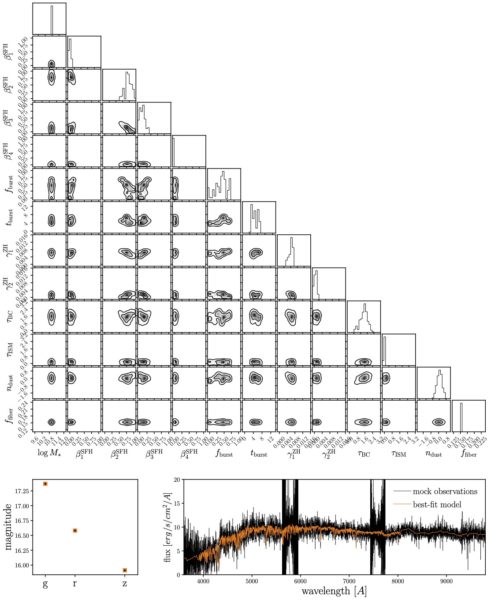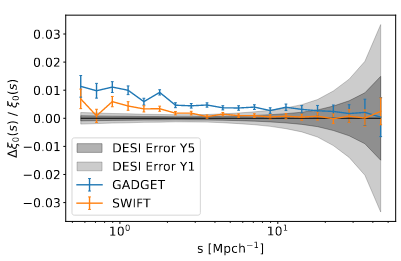The DESI PRObabilistic Value-Added Bright Galaxy Survey (PROVABGS) Mock Challenge
 The PRObabilistic Value-Added Bright Galaxy Survey (PROVABGS) catalog will provide measurements of galaxy properties, such as stellar mass, star formation rate (SFR), stellar metallicity (ZMW), and stellar age (tage,MW), for over 10 million galaxies of the DESI Bright Galaxy Survey. Full posterior distributions of the galaxy properties will be inferred using state-of-the-art Bayesian spectral energy distribution (SED) modeling of DESI spectroscopy and photometry. The figure shows an example of such a posterior over properties including stellar mass, star formation history (β1, β2, β3, β4, fburst, tburst), and metallicity history (γ1, γ2). In this work, we present all the methodology that will be used to construct the PROVABGS catalog.
The PRObabilistic Value-Added Bright Galaxy Survey (PROVABGS) catalog will provide measurements of galaxy properties, such as stellar mass, star formation rate (SFR), stellar metallicity (ZMW), and stellar age (tage,MW), for over 10 million galaxies of the DESI Bright Galaxy Survey. Full posterior distributions of the galaxy properties will be inferred using state-of-the-art Bayesian spectral energy distribution (SED) modeling of DESI spectroscopy and photometry. The figure shows an example of such a posterior over properties including stellar mass, star formation history (β1, β2, β3, β4, fburst, tburst), and metallicity history (γ1, γ2). In this work, we present all the methodology that will be used to construct the PROVABGS catalog.
The DESI N-body Simulation Project I: Testing the Robustness of Simulations for the DESI Dark Time Survey
 We test that our computer simulations of gravity are robust to help DESI extract information about the evolution of the Universe. The figure shows the differences between our simulated universes and the precision of the DESI survey.
We test that our computer simulations of gravity are robust to help DESI extract information about the evolution of the Universe. The figure shows the differences between our simulated universes and the precision of the DESI survey.
The DESI N-body Simulation Project II: Suppressing Sample Variance with Fast Simulations
Deep Learning of DESI Mock Spectra to Find Damped Lyman-α Systems
We have updated and applied a convolutional neural network (CNN) machine learning model to discover and characterize damped Lyman-α systems (DLAs) based on DESI mock spectra. We have optimized the training process and constructed a CNN model that yields a DLA classification accuracy above 99% for spectra which have signal-to-noise above 5 per pixel.
Rosella: A mock catalogue from the P-Millennium simulation
The Rosella mock provides information about r-band absolute magnitudes, (g–r) rest-frame colors, 3D positions and velocities of a complete sample of DESI Bright Galaxy Survey (BGS) galaxies, as well as the masses of host dark matter haloes. This P-Millennium DESI BGS mock catalogue is ideally suited for the tuning of approximate mocks unable to resolve subhalos that DESI BGS galaxies reside in, to test for systematics in analysis pipelines, and to interpret (non-cosmological focused) DESI BGS analysis.
LyaCoLoRe: Synthetic Datasets for Current and Future Lyman-α Forest BAO Surveys
LyaCoLoRe is a package for producing synthetic Lyman-α forest survey datasets for BAO analyses. LyaCoLoRe transforms initial Gaussian random field skewers into skewers of transmitted flux fraction via a number of fast approximations. In this work we explain the methods of producing mock datasets used in LyaCoLoRe, and then measure correlation functions on a suite of realizations of such data. We demonstrate that we are able to recover the correct BAO signal, as well as large-scale bias parameters similar to literature values.